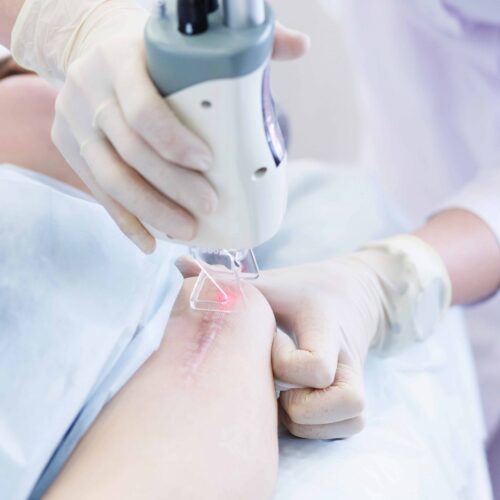Sculpt Sublime- Plastic Surgery Clinic in Mumbai
Scar Revision
What is a scar?
The body’s natural method of repairing and replacing lost or damaged skin is to leave a scar. Fibrous tissue frequently makes up scars. Scars can develop for a variety of reasons, including infections, surgery, traumas, or tissue inflammation. Anywhere on the body, a scar can develop, and its structure might differ, appearing flat, lumpy, sunken, or coloured. The scar could hurt or itch. The final appearance of a scar is influenced by a number of variables, including the person’s age, nutritional state, skin type, where the scar is on the body, and the direction of the incision.

What is a scar revision?
A surgery to change a scar’s appearance is known as a scar revision. The repair may enhance the scar’s aesthetic appeal, allow movement in a body region that the scar may have limited, or soothe an itchy scar. It’s critical to keep in mind that scars cannot be entirely eliminated.
What are the different types of scars and scar treatments?
There are many different types of scars, including the following:
Keloid scars and scar tissue removal
This is a term used to describe huge, spherical, asymmetrical clusters of scar tissue that develop at the location of a skin wound but spread beyond its borders. They usually have redder or darker skin than the neighbouring normal skin. To repair the damage, skin cells and connective tissue (fibroblasts) begin to multiply, which leads to the development of keloids. Although the face, neck, ears, chest, or shoulders are the most frequently affected areas, these scars can appear anywhere on the body. Darker skinned people encounter them more regularly. Keloid scars may form up to a year after the original skin damage.
Treatment for keloid scars varies. There is no one simple cure for keloid scar removal. Recurrence after treatment is common. Treatment may include the following:
- Steroid injections. To assist lessen the stinging, burning, and redness that these scars may cause, steroids are directly injected into the keloid scar tissue. In certain cases, the injections really assist in reducing the scar’s size.
- Cryotherapy involves the scar being “frozen” off by a medication. This treatment is often effective in conjunction with steroid injections for keloid scars.
- Pressure therapy. Pressure therapy involves a type of pressure appliance worn over the area of the keloid scar. These may be worn day and night for up to 4 to 6 months.
- Surgery may be performed if nonsurgical therapy approaches are ineffective for treating the keloid scar. In one kind of surgery, the scar is directly removed through an incision, and stitches are used to assist seal the wound. Skin grafts may occasionally be applied to assist close the wound. This entails adding skin to the missing area or replacing it. When doing skin grafts, a healthy patch of skin is removed from the donor site and stitched to the place that needs it.
- Laser surgery is an additional keloid scar therapy option. Depending on the underlying cause of the scar, different lasers may be used to cure it. A scar may be flattened, have its odd hue removed, or smoothed with laser technology. The majority of times, steroid injections, specialised dressings, and bandages are used in conjunction with laser therapy to treat keloid scars. Regardless of the first therapeutic kind, multiple treatments can be necessary.
FAQs
What is done in plastic surgery?
What is the difference between cosmetic and reconstructive surgery?
Cosmetic surgery is performed to reshape normal structures of the body in order to improve appearance and self-esteem. Cosmetic surgery is usually not covered by health insurance because it is elective.
Reconstructive surgery is performed on abnormal structures of the body caused by congenital defects, developmental abnormalities, trauma, infection, tumors or disease. In general, reconstructive surgery is performed to improve function, but may also be completed to approximate a normal appearance.
Reconstructive surgery is typically covered by most health insurance policies, although coverage for specific procedures and levels of coverage may vary greatly.
If I have Botox or Restylane, how often would I need to repeat the injections?
Botox lasts about three to four months, and the treatment can be repeated as needed. When it wears off, you will begin to notice increased muscle action and some reformation of the wrinkles. It appears that with repeated use, the effect of Botox becomes longer lasting.
Restylane injections last for about six months, and can also be repeated as needed.
How do I know what size breast implant is right for me?
The decision is based on a number of factors, including the patient’s desires, reasons for the surgery and overall health.
For example, are you doing it because you feel your breasts are too small relative to your body contour or are you unhappy with the size and firmness of your breasts following pregnancy, breastfeeding or major weight loss? Unevenness between the breasts can also be a motivating factor. Your surgeon can help you make the right decision during your pre-surgical appointment(s).